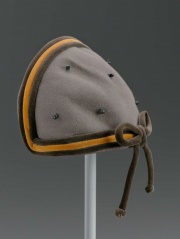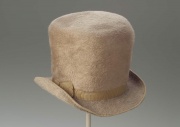Felt
Description
A nonwoven textile composed of matted Cotton, Wool ,or Hair fibers matted together with through mechanical, chemical, or thermal processes, such as heat and moisture. The oldest known fabric samples, excavated in Turkey, are made of wool felt and date to at least 6500 BCE. Felt was usually made from sheep's wool, Goat hair, or Camel hair. Occasionally vegetable fibers (e.g., Cotton, Kapok), rags, recycled paper or synthetic fibers are used for felt. Felt is a good insulator for both temperature and noise. It has been used to make hats, blankets, rugs, insulation, filtration, polishing cloths, and absorbent cloths, as well as to line boxes and instrument cases. Synthetic fibers are also being used for felting include acrylic, polyester and polypropylene. See also Polyfelt, Polyester felt and Acrylic felt.
Synonyms and Related Terms
fur felt; wool felt; Filz (Deut.); feutre (Fr.); vilt (Ned.); fieltro (Esp.)
Properties
| Property | 100% Wool Felt | Wool Blend Felt | Acrylic Felt | Polyester Felt | Polypropylene Felt |
|---|---|---|---|---|---|
| Fiber Composition | 100% wool (often Merino) | Wool blended with rayon or acrylic | 100% acrylic fibers | 100% polyester fibers | 100% polypropylene fibers |
| Texture | Soft, smooth, matte appearance | Smooth, slightly "squeaky", slight sheen | Can be fuzzy or hard, sheen | Slightly fuzzy, soft surface | Can be smooth to fuzzy |
| Durability | Very durable, resists pilling | Durable, but less so than 100% wool | Less durable, can pill and fuzz | Durable, resists tearing and fraying | Durable, resists tearing and fraying |
| Warmth | Excellent insulation | Good insulation | Less warm | Moderate insulation | Less warm |
| Water Repellency | Naturally water-repellent | Somewhat water-repellent | Not water-repellent | Water-resistant | Water-repellent |
| Care | Hand wash, may shrink | Hand wash, may shrink | Machine washable | Machine washable | Machine washable |
| Cost | Most expensive | Moderately priced | Least expensive | Moderately priced | Moderately priced |
| Colorfastness | Holds dyes well, some colors may fade | Good colorfastness | Excellent colorfastness | Excellent colorfastness | Good colorfastness |
| Personal Risks | Can cause allergies | Less likely to cause allergies | Hypoallergenic | Hypoallergenic | Hypoallergenic |
Resources and Citations
- M.E.Burkett, "Felt" The Dictionary of Art Vol. 10, Grove's Publishing Inc., New York, 1996.
- Fairchild's Dictionary of Textiles, Phyllis G.Tortora, Robert S. Merkel (eds.), Fairchild Publications, New York City, 7th edition, 1996
- The Dictionary of Paper, American Paper Institute, New York, Fourth Edition, 1980
- E.J.LaBarre, Dictionary and Encyclopedia of Paper and Paper-making, Swets & Zeitlinger, Amsterdam, 1969
- The Dictionary of Art, Grove's Dictionaries Inc., New York, 1996 Comment: "Felt" M.E. Burkett
- Wikipedia: http://en.wikipedia.org/wiki/Felt (Accessed Nov. 29, 2005)
- Hoechst Celanese Corporation, Dictionary of Fiber & Textile Technology (older version called Man-made Fiber and Textile Dictionary, 1965), Hoechst Celanese Corporation, Charlotte NC, 1990
- Matt Roberts, Don Etherington, Bookbinding and the Conservation of Books: a Dictionary of Descriptive Terminology, U.S. Government Printing Office, Washington DC, 1982
- Dictionary of Building Preservation, Ward Bucher, ed., John Wiley & Sons, Inc., New York City, 1996
- Edward Reich, Carlton J. Siegler, Consumer Goods: How to Know and Use Them, American Book Company, New York City, 1937
- Art and Architecture Thesaurus Online, http://www.getty.edu/research/tools/vocabulary/aat/, J. Paul Getty Trust, Los Angeles, 2000

